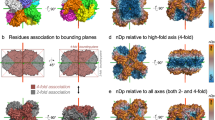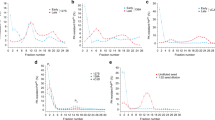Abstract
A homomer is formed by self-interacting copies of a protein unit. This is functionally important1,2, as in allostery3,4,5, and structurally crucial because mis-assembly of homomers is implicated in disease6,7. Homomers are widespread, with 50–70% of proteins with a known quaternary state assembling into such structures8,9. Despite their prevalence, their role in the evolution of cellular machinery10,11 and the potential for their use in the design of new molecular machines12,13, little is known about the mechanisms that drive formation of homomers at the level of evolution and assembly in the cell9,14. Here we present an analysis of over 5,000 unique atomic structures and show that the quaternary structure of homomers is conserved in over 70% of protein pairs sharing as little as 30% sequence identity. Where quaternary structure is not conserved among the members of a protein family, a detailed investigation revealed well-defined evolutionary pathways by which proteins transit between different quaternary structure types. Furthermore, we show by perturbing subunit interfaces within complexes and by mass spectrometry analysis15, that the (dis)assembly pathway mimics the evolutionary pathway. These data represent a molecular analogy to Haeckel’s evolutionary paradigm of embryonic development, where an intermediate in the assembly of a complex represents a form that appeared in its own evolutionary history. Our model of self-assembly allows reliable prediction of evolution and assembly of a complex solely from its crystal structure.
This is a preview of subscription content, access via your institution
Access options
Subscribe to this journal
Receive 51 print issues and online access
$199.00 per year
only $3.90 per issue
Buy this article
- Purchase on Springer Link
- Instant access to full article PDF
Prices may be subject to local taxes which are calculated during checkout




Similar content being viewed by others
References
Cabezon, E. et al. Homologous and heterologous inhibitory effects of ATPase inhibitor proteins on F-ATPases. J. Biol. Chem. 277, 41334–41341 (2002)
Hardy, L. W. et al. Atomic structure of thymidylate synthase: target for rational drug design. Science 235, 448–455 (1987)
Iber, D., Clarkson, J., Yudkin, M. D. & Campbell, I. D. The mechanism of cell differentiation in Bacillus subtilis . Nature 441, 371–374 (2006)
Marianayagam, N. J., Sunde, M. & Matthews, J. M. The power of two: protein dimerization in biology. Trends Biochem. Sci. 29, 618–625 (2004)
Monod, J., Wyman, J. & Changeux, J. P. On the nature of allosteric transitions: a plausible model. J. Mol. Biol. 12, 88–118 (1965)
Dobson, C. M. Protein folding and misfolding. Nature 426, 884–890 (2003)
Hayouka, Z. et al. Inhibiting HIV-1 integrase by shifting its oligomerization equilibrium. Proc. Natl Acad. Sci. USA 104, 8316–8321 (2007)
Levy, E. D., Pereira-Leal, J. B., Chothia, C. & Teichmann, S. A. 3D complex: a structural classification of protein complexes. PLoS Comput. Biol. 2, e155 (2006)
Goodsell, D. S. & Olson, A. J. Structural symmetry and protein function. Annu. Rev. Biophys. Biomol. Struct. 29, 105–153 (2000)
Ispolatov, I., Yuryev, A., Mazo, I. & Maslov, S. Binding properties and evolution of homodimers in protein–protein interaction networks. Nucleic Acids Res. 33, 3629–3635 (2005)
Pereira-Leal, J. B., Levy, E. D., Kamp, C. & Teichmann, S. A. Evolution of protein complexes by duplication of homomeric interactions. Genome Biol. 8, R51 (2007)
Grueninger, D. et al. Designed protein–protein association. Science 319, 206–209 (2008)
Janin, J. Biochemistry. Dicey assemblies. Science 319, 165–166 (2008)
Blundell, T. L. & Srinivasan, N. Symmetry, stability, and dynamics of multidomain and multicomponent protein systems. Proc. Natl Acad. Sci. USA 93, 14243–14248 (1996)
Hernandez, H. et al. Subunit architecture of multimeric complexes isolated directly from cells. EMBO Rep. 7, 605–610 (2006)
Brinda, K. V. & Vishveshwara, S. Oligomeric protein structure networks: insights into protein–protein interactions. BMC Bioinformatics 6, 296 (2005)
Monod, J. Nobel Symposium 11: Symmetry and Function of Biological Systems at the Macromolecular Level (Almqvist & Wiksell, Stockholm, 1968)
Lukatsky, D. B., Shakhnovich, B. E., Mintseris, J. & Shakhnovich, E. I. Structural similarity enhances interaction propensity of proteins. J. Mol. Biol. 365, 1596–1606 (2007)
Claverie, P., Hofnung, M. & Monod, J. Sur certaines implications de l'hypothèse d'équivalence stricte entre les protomères des protéines oligomériques. C. R. Séanc. Acad. Sci. 266, 1616–1618 (1968)
DePristo, M. A., Weinreich, D. M. & Hartl, D. L. Missense meanderings in sequence space: a biophysical view of protein evolution. Nature Rev. Genet. 6, 678–687 (2005)
Bahadur, R. P., Rodier, F. & Janin, J. A dissection of the protein-protein interfaces in icosahedral virus capsids. J. Mol. Biol. 367, 574–590 (2007)
Powers, E. T. & Powers, D. L. A perspective on mechanisms of protein tetramer formation. Biophys. J. 85, 3587–3599 (2003)
Luke, K. & Wittung-Stafshede, P. Folding and assembly pathways of co-chaperonin proteins 10: Origin of bacterial thermostability. Arch. Biochem. Biophys. 456, 8–18 (2006)
Cheesman, C., Ruddock, L. W. & Freedman, R. B. The refolding and reassembly of Escherichia coli heat-labile enterotoxin B-subunit: analysis of reassembly-competent and reassembly-incompetent unfolded states. Biochemistry 43, 1609–1617 (2004)
Kress, W., Mutschler, H. & Weber-Ban, E. Assembly pathway of an AAA+ protein: tracking ClpA and ClpAP complex formation in real time. Biochemistry 46, 6183–6193 (2007)
Levy, E. D. PiQSi: Protein quaternary structure investigation. Structure 15, 1364–1367 (2007)
Sobott, F. et al. A tandem mass spectrometer for improved transmission and analysis of large macromolecular assemblies. Anal. Chem. 74, 1402–1407 (2002)
Hernandez, H. & Robinson, C. V. Determining the stoichiometry and interactions of macromolecular assemblies from mass spectrometry. Nature Protocols 2, 715–726 (2007)
Acknowledgements
We thank the collaborators listed in Supplementary Table 2 for supplying the different complexes and acknowledge H. Hernandez, J. Freeke and L. Lane for assistance with mass spectrometry. We also thank C. Chothia, J. Clark and M. Babu for discussions. This work was supported by the Medical Research Council, the EMBO Young Investigators Programme, the Royal Society and the Waters Kundert Trust.
Author Contributions E.D.L., E.B.E., C.V.R. and S.A.T. designed the experiments and wrote the manuscript; E.D.L. and E.B.E. performed the bioinformatics and mass spectrometry experiments, respectively.
Author information
Authors and Affiliations
Corresponding authors
Supplementary information
Supplementary Information
The file contains Supplementary Discussions 1-2; Supplementary Figures 1-4 and Supplementary Tables 1-3. This file contains discussions on the hierarchy in interface size, and on membrane proteins; figures on conservation of QS and transitions between them, on our model of QS evolution, and on the MS protocol used for disassembly. Tables list complexes used for the evolutionary and MS analyses, and those from the literature. (PDF 818 kb)
Rights and permissions
About this article
Cite this article
Levy, E., Erba, E., Robinson, C. et al. Assembly reflects evolution of protein complexes. Nature 453, 1262–1265 (2008). https://doi.org/10.1038/nature06942
Received:
Accepted:
Published:
Issue Date:
DOI: https://doi.org/10.1038/nature06942
This article is cited by
-
Self-similar chiral organic molecular cages
Nature Communications (2024)
-
Agglomeration: when folded proteins clump together
Biophysical Reviews (2023)
-
Designed and biologically active protein lattices
Nature Communications (2021)
-
Complete and cooperative in vitro assembly of computationally designed self-assembling protein nanomaterials
Nature Communications (2021)
-
Asymmetrizing an icosahedral virus capsid by hierarchical assembly of subunits with designed asymmetry
Nature Communications (2021)
Comments
By submitting a comment you agree to abide by our Terms and Community Guidelines. If you find something abusive or that does not comply with our terms or guidelines please flag it as inappropriate.



